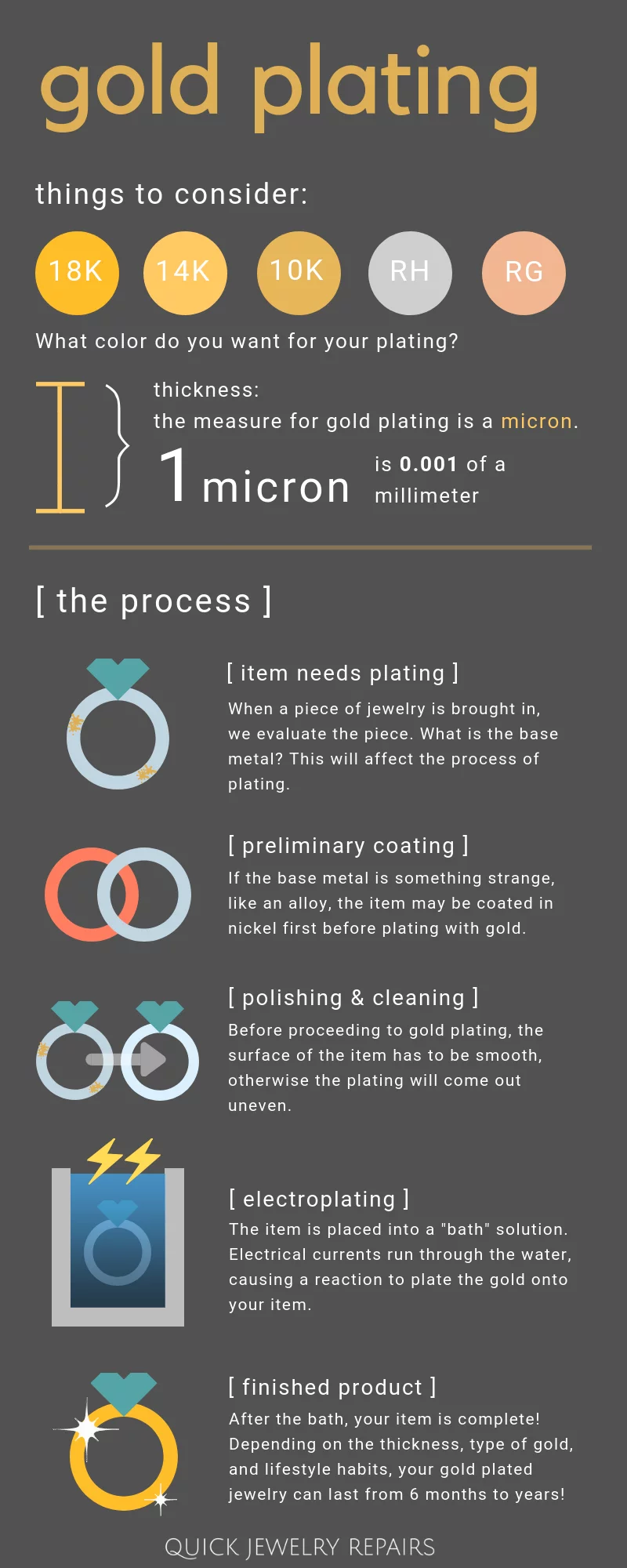Gold Plating Process Explained
Gold plating is a method of depositing a thin layer of gold onto the surface of another metal, typically silver or copper. This process involves using an electrochemical or immersion plating technique to achieve a desired gold finish.
How is Gold Plating Done?
Gold plating is typically done through one of two methods: electroplating or electroless plating. In electroplating, an electric current is passed through a solution containing gold and a chemical compound, causing the gold ions to attach to the metal surface. Electroless plating, on the other hand, uses a chemical reaction to deposit gold onto the metal without the need for electricity.

This image is property of quickjewelryrepairs.com.
Benefits of Gold Plating
Gold plating offers several advantages, making it a popular choice for jewelry, electronics, and decorative items.
Durability
Gold plating provides a durable and scratch-resistant surface that can withstand everyday wear and tear. This makes it an ideal choice for items that are frequently handled or exposed to harsh conditions.
Aesthetics
Gold plating enhances the appearance of an object, giving it a luxurious and sophisticated look. The bright metallic luster of gold adds an element of elegance to any item, making it highly attractive to consumers.
Corrosion Resistance
Gold plating provides excellent corrosion resistance, protecting the underlying metal from the effects of moisture, chemicals, and other environmental factors. This helps to prolong the life of the plated item and maintain its original condition.
Factors Influencing Gold Plating Quality
The quality of gold plating can vary depending on several factors, including the thickness of the gold layer, the purity of the gold used, and the plating method employed.
Thickness of Gold Layer
The thickness of the gold layer applied during plating affects the durability and longevity of the finished product. A thicker layer of gold provides better protection against wear and tear, ensuring that the plating lasts longer.
Purity of Gold
The purity of the gold used for plating can also impact the quality of the finish. Higher purity gold, such as 24 karat, produces a brighter and more lustrous appearance compared to lower purity alloys.
Plating Method
The method used for gold plating, whether electroplating or electroless plating, can influence the adhesion, coverage, and appearance of the gold layer. Each method has its own advantages and limitations, so it is essential to choose the most suitable technique for the desired outcome.

This image is property of diamondbuzz.blog.
Common Applications of Gold Plating
Gold plating is utilized in a wide range of industries and applications, ranging from jewelry and watchmaking to electronics and aerospace.
Jewelry
Gold plating is commonly used in the jewelry industry to create affordable pieces that mimic the appearance of solid gold. By applying a thin layer of gold to a base metal, jewelers can offer luxurious-looking items at a fraction of the cost.
Electronics
Gold plating is employed in the electronics industry for its superior electrical conductivity and corrosion resistance. It is used to plate connectors, contacts, and circuit boards to enhance performance and reliability.
Decorative Items
Gold plating is popular for decorative purposes, as it adds a touch of elegance and luxury to everyday objects. Items such as tableware, trophies, and architectural details are often gold plated for aesthetic appeal.

This image is property of cdn.shopify.com.
Conclusion
In summary, gold plating is a versatile and effective process that offers numerous benefits for a wide range of applications. By understanding how gold plating works, investors can make informed decisions about incorporating this technique into their projects and investments. With its durability, aesthetics, and corrosion resistance, gold plating remains a valuable and sought-after finishing option in various industries.
If you have any questions, please don’t hesitate to contact us at info@fastcashdc.com



